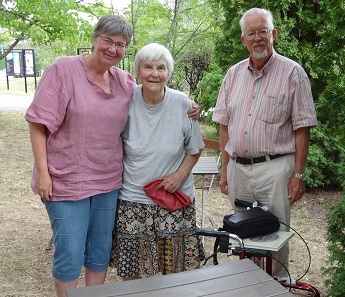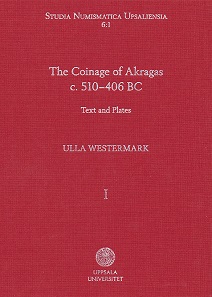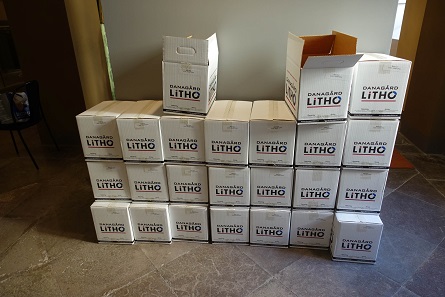Written by Ursula Kampmann
Translated by Leonie Schulze
August 2, 2018 – Only once in my life did two professors at once ask me to give flowers in their name to a numismatist upon me visiting her. With her calm, friendly, and humble modesty, Ulla Westermark has won many numismatic friends (and admirers), who also highly respect her due to her profound knowledge of Greek numismatics. When she retired as the director of the Royal Coin Cabinet in Stockholm, she very much looked forward to resuming a task she had taken over in the late 1960s already: to write a standard work on the coinage of ancient Akragas including a corpus of dies. She finished the script in 2004. But by that time, modern technology had advanced to such a degree that illustrations as well as editing had to meet new standards in order to be published. Whether it was digital images or the adjustment to a writing software compatible with modern computers, we owe it to Harald Nilsson and Hendrik Mäkeler that the important script did not remain in a desk drawer. Alongside many good souls, they organized the adaptation to modern-day technology and thus “The Coinage of Akragas c. 510-406” could be published in 2018 as the 6th volume of the Studia Numismatica Upsaliensia.
We got the opportunity to personally pick up our copies of both of Ulla Westermark’s books in Uppsala. From left to right: Ursula Kampmann, Ulla Westermark, Harald Nilsson. Photo: KW.
This work, which Ulla Westermark was engaged in for several decades, contains two volumes of more than 600 pages and more than 80 illustrations. First and foremost, you will of course find a detailed catalog. Flipping through the 293 pages, you will understand why this work took so many years to write. The author covers the entire coinage including fractions and bronze – she clearly had to manage an immense amount of material. Her catalog meets all the standards set by numismatics. And anyone who has to identify coins will appreciate the continuous numbering. Thanks to this catalog, it is now possible to determine the provenance of those coins of Akragas that were presented in auction catalogs or lists before 2004.
However, this still requires an additional well-organized library including the most important auction catalogs as the vast amount of material only allowed the most well-preserved specimens to be illustrated in this book.
Ulla Westermark, The Coinage of Akragas, c. 510-406 BC. Volume I and II. Studia Numismatica Upsaliensia 6:1 und 6:2. Uppsala University 2018. 256 + 396 pp. 12 +71 pl. 19 x 25 cm. ISBN 978-91-513-0269-0 and 978-91-513-0270-6. 305 or 338 SEK + shipping and packaging.
The commentary of 170 pages includes an introductory chapter on the history of the city, a detailed chapter on the depicted animals eagle and crab, as well as a detailed study on every aspect of the coinage of Akragas. The latter continues alongside the catalog and successively covers all coin groups and eras. Lovers of distinct writing styles will appreciate Ulla Westermark’s clear and precise language. Short and easily comprehensible sentences ensure a pleasurable reading experience. You won’t find linguistic labyrinths, which use elaborate phrasal constructions to hide the fact that the author really doesn’t have anything to say. Because Ulla Westermark does have something to say. She describes what she sees and her profound knowledge of ancient Greek coins minted in the same era, allows her to put her observations into a greater context. In an almost minutely detailed manner, she lists everything other researchers have said before her about the topics she covers and then adds her own opinion – often unassumingly written in the subjunctive.
A list of hoards, a bibliography of almost 50 pages, as well as a graphic rendering of the distribution of inscriptions on the coins of Akragas (whoever has to classify these coins in a worse grade than “extremely fine” will appreciate this aid) complete this book.
Copies of this book are awaiting orders at the Coin Cabinet of Uppsala. Foto: KW.
Do I have to recommend purchasing this book? Of course not, as everyone who is seriously engaged in Greek coinage knows they need it. It can be purchased at the very reasonable price of 305 SEK for the first and 338 SEK for the second volume including postage. That is equivalent to less than 70 euros.
While you find yourself on the Studia numismatica Upsaliensia website, we also want to point to some other affordable publications which can be purchased there. For example, the second volume on the German coins of the High and Late Middle Ages in the collection of the coin cabinet of the University of Uppsala (written in German, price: 204 SEK) or Ragnar Hedlund’s study on the coinage of the Roman barracks emperors after 260 AD (written in English, sold at an equally reasonable price of 262 SEK).
A downright essential purchase for collectors of medals are the two catalogs on musical and medical-historical medals (Volume 7 – 350 SEK and Volume 8 – 457 SEK).
We recommend using this opportunity to enlarge one’s personal library.
We presented the last catalog on medical-historical medals on our CoinsWeekly website.
If you want to visit Akragas – visually at least – you can get a glimpse in our numismatic diary.








